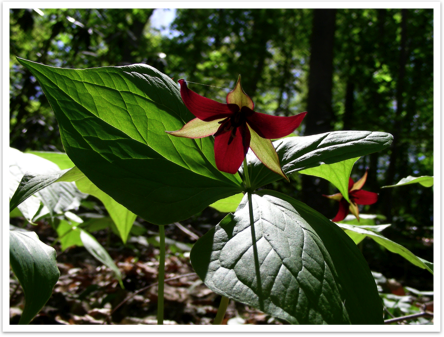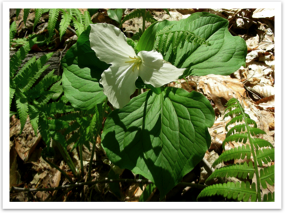Trillium
Trillium is to me the epitomal magic wildflower, its bursts of white especially fairylike in the dark second-growth evergreen forests I grew up in. To this day, I have a implacable childhood belief that one should never pick or disturb a trillium, for it will never grow back in the same place.
Curiously, Palmer seems to have only collected T. cernuum, (nodding trillium), which I’ve never seen. He did not illustrate or check off in his fieldguide any of the other species. Nowadays the steep slope in between Crumhenge and the Blue Route is covered with what I take to be T. grandiflorum and T. erectum to such an extent that the Crum Woods Stewardship Committee calls it ‘Trillium Slope’. It’s possible that they are descendants of cultivated plants in the Oak Knoll estate garden, which in Palmer’s day would not have been the picturesque ruin it is now.
Trillium spp.



One of the earliest articles about Trillium-ant interaction is Charles Robertson, 1889. Seed Crests and Myrmecophilous Dissemination in Certain Plants. Botanical Gazette 23(4). JStor link.
Above: T. grandiflorum, large flowered trillium
Right: T. erectum, called ‘Wake-Robin’ among its many other colorful names, is widespread, but I hadn’t seen it before I came to Swarthmore, and was shocked to discover that the college had a trillium in its school color, garnet.
Trillium species are one of the archetypal plants with mymrecophilous dissemination, that is, whose seeds are spread by ants (and yellow-jackets) attracted by a small, yummy, oily, fruit-like appendage called an elaisome. The insects carry the seed off to eat the elaisome, then discard the seed to grow as part of the rich ecosystem inside ant-middens. This method of distribution had been observed as early as the 1880’s and is still studied today. Bloodroot is another species with myrmecophilous dissemination.
Samuel B. Palmer
Biology Dept.
Swarthmore College
Biology Dept.
Swarthmore College


Monday, May 1, 2006
All of the Palmer Watercolors are courtesy of the Biology Department of Swarthmore College. A searchable database of the images is available through the Swarthmore library’s Triptych site.